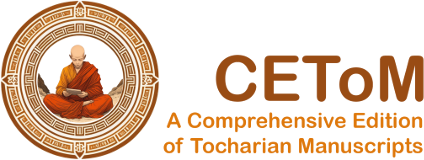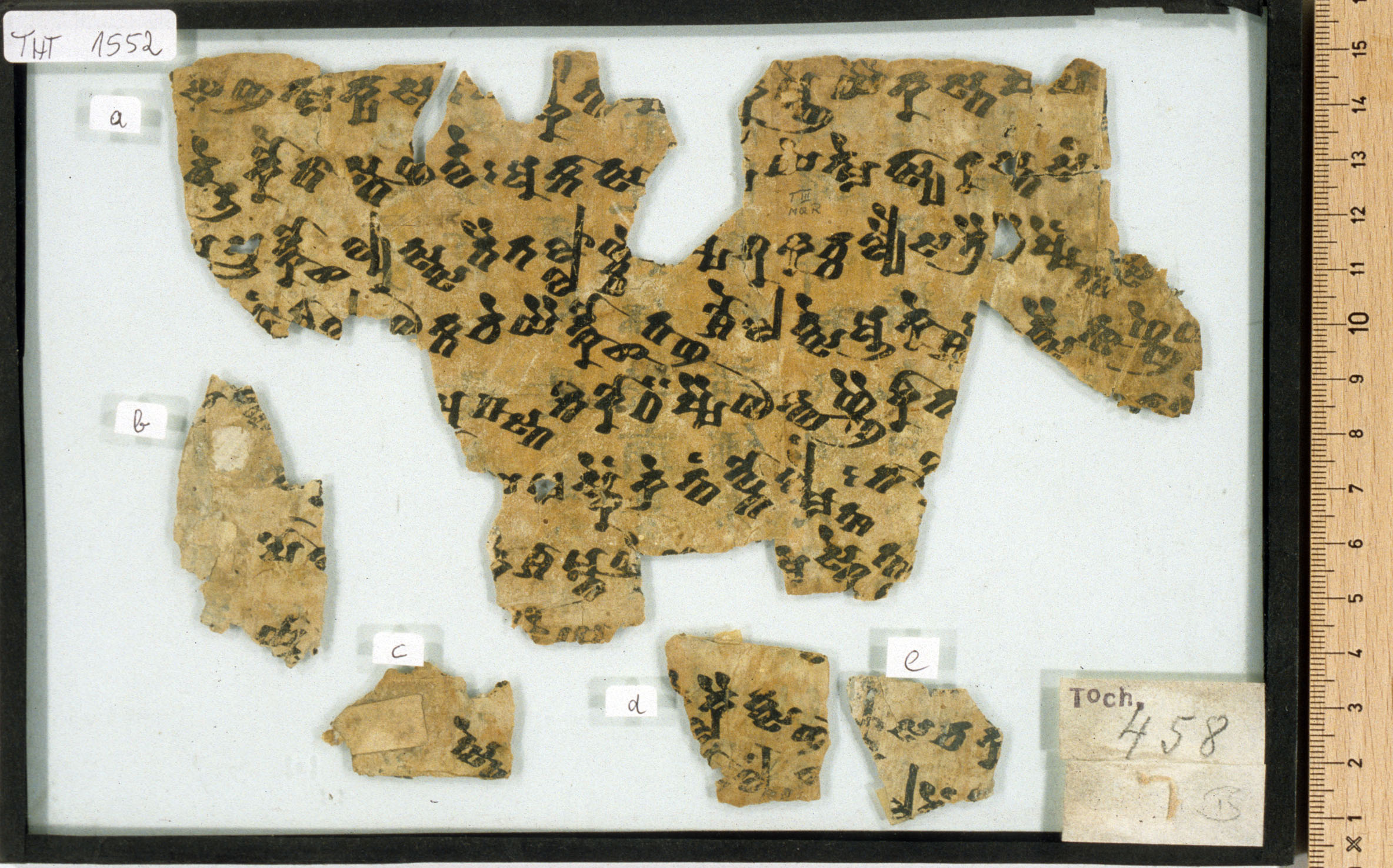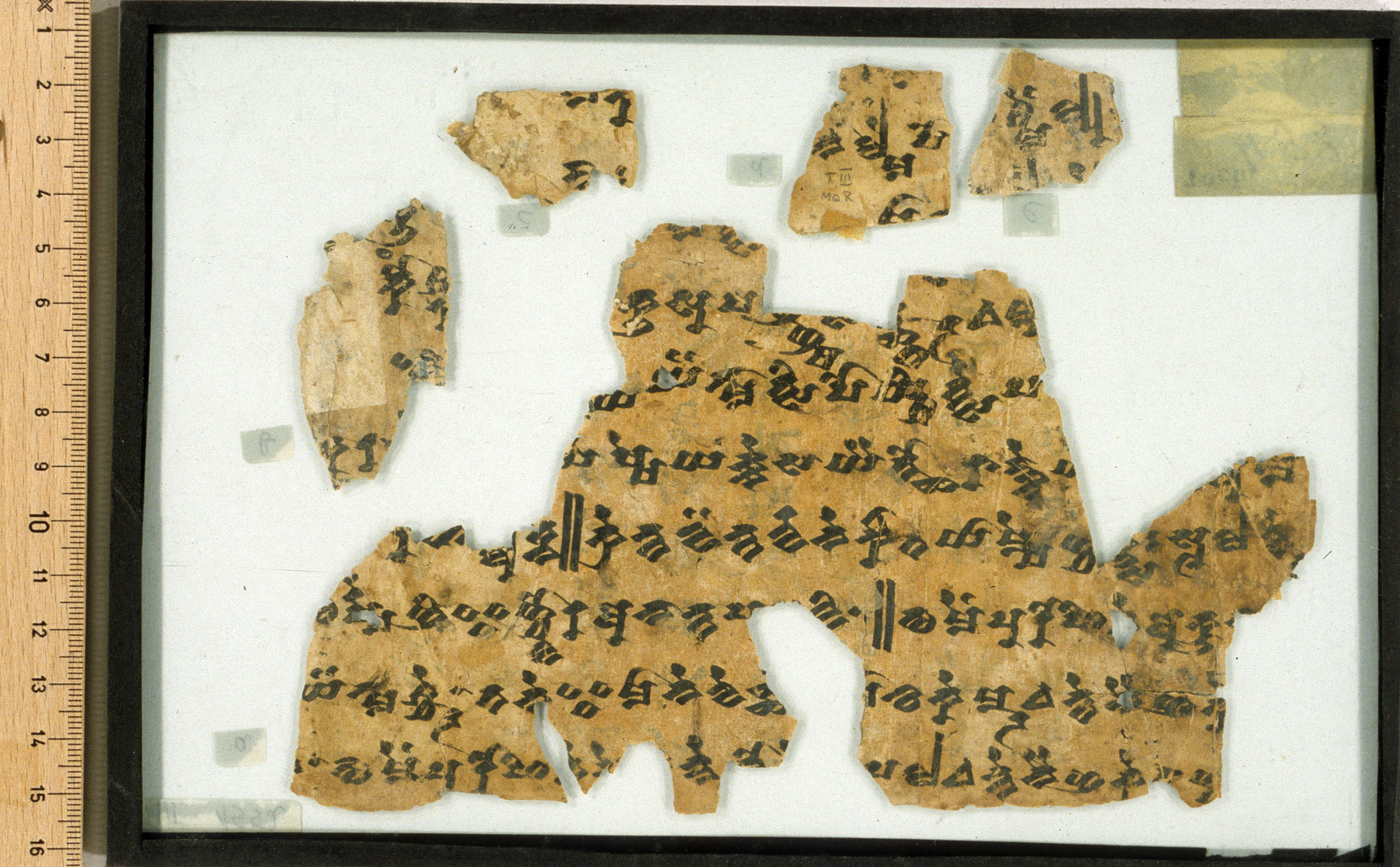THT 520
| Known as: | THT 520; B 520; THT 1552.a |
|---|---|
| Cite this page as: | Adrian Musitz (translation). "THT 520". In A Comprehensive Edition of Tocharian Manuscripts (CEToM). Created and maintained by Melanie Malzahn, Martin Braun, Hannes A. Fellner, and Bernhard Koller. https://cetom.univie.ac.at/?m-tht520 (accessed 13 Jul. 2025). |
Edition | |
| Editor: | Adrian Musitz (translation) |
Provenience | |
| Main find spot: | Kizil Ming-öy |
| Specific find spot: | Rothkuppelraum |
| Expedition code: | T III MQR 105 |
| Collection: | Berlin Turfan Collection |
Language and Script | |
| Language: | TB |
| Linguistic stage: | classical |
| Script: | classical |
Text contents | |
| Title of the work: | Buddhastotra incorporated into a drama |
| Text genre: | Literary |
| Text subgenre: | Drama |
| Verse/Prose: | prose; verse |
Object | |
| Manuscript: | THT 520 |
| Material: | ink on paper |
| Form: | Poṭhī |
| Number of lines: | 8 |
Images
Images from idp.bl.uk by courtesy of the International Dunhuang Project, the Berlin-Brandenburgische Akademie der Wissenschaften, and the Staatsbibliothek zu Berlin – Orientabteilung.
Transliteration
| a1 | /// sa ña nmā kṣā s[t]a : [pi] lko nta [ṣṣ]· – ·k· mñe yai ka sta ṣ[e] p· /// |
|---|---|
| a2 | /// ce¯ ¯u kau tā sta ñ[e] rwe : a knā tsa – – ye nme tsyā ra sta saṃ /// |
| a3 | /// p[e] pru tko¯ ¯s̝ lyu tstsa tai ta llā ñcc[e] – ṣṣ· 7 ka cca lyai sa trai [ś]ai ṣṣeṃ¯ ¯ts ·s· /// |
| a4 | /// ··ṃ śī l[tsa] o kta ce yai tko¯ ¯s̝ ta¯ ¯ñ śau la ntse ā ke¯ ¯ś : – ttsai tsa ññe [y]· /// |
| a5 | /// yśi ka ṣṣi y[ai] pu pa¯ ¯st ni ro dhä ṣṣai o nwa ññai rī nā /// |
| a6 | /// mā pe rā [ks̝pa] ya ma skeṃ kre ntaṃ wno lmeṃ¯ ¯ts : nā [k]i /// |
| a7 | /// lmeṃ¯ ¯ts cme t[s]i ne śā mna ñ·e – – nma ske nt[ra] /// |
| a8 | /// |
| b1 | /// |
| b2 | /// ·[ś]· ntaṃ tsno na [nā] ku su ṣa ña¯ ¯ñm s· [k]s̝ta¯ ¯r e m[pa] /// |
| b3 | /// rk[o]¯ ¯y : skā – ya yä nmā tsi po yśi ntse pa /// |
| b4 | /// ṣke ntse ke rc[c]i ye· ṣṣe ya kne sa yai to¯ ¯s̝ rā ṅkne [y]· – – [a] m· /// |
| b5 | /// ri ṇa [p]lu tn· || kre nta wä nta rwa ne kī ta yā mṣe ñca [k]us· : sū l· ntaṃ[¯] [¯ts] /// |
| b6 | /// [o] rṣṣe ñi i ñcwo ra a nā nta pa – wi 1 || tu meṃ pu ro hi [t]e a krū [n]· /// |
| b7 | /// yä nma śce¯ ¯r • ta ne i mā ne we s̝s̝a[ṃ] – [m]ā ai ke ma¯ ¯r e nte nai ña ke /// |
| b8 | /// • tu meṃ pu ro hi te [p]·e – nne ·o· [e] – pa la e nte nai ña ke [ma] [ñc]· /// |
Transcription
| a1 | /// sañanm= ākṣāsta : pilkontaṣṣ(e) (or)k(a)mñe yaikasta ṣe p· /// |
|---|---|
| a2 | /// ceu kautāsta ñerwe : aknātsa(ññeṣṣe) yenme tsyārasta saṃ /// |
| a3 | /// peprutkoṣ lyutstsatai tallāñcn1 ce (śai)ṣṣ(e) 7 kaccalyaisa trai śaiṣṣeṃts ·s· /// |
| a4 | /// ··ṃ śīltsa oktace yaitkoṣ tañ śaulantse ākeś : (kä)ttsaitsäññe y· /// |
| a5 | /// yśi käṣṣi yaipu päst nirodhäṣṣai onwaññai rīn= ā /// |
| a6 | /// mā perāk ṣpä yamaskeṃ krentäṃ wnolmeṃts : nāki /// |
| a7 | /// lmeṃts cmetsine śāmna ñ·e – – nmaskenträ /// |
| a8 | /// |
| b1 | /// |
| b2 | /// ·ś·ntaṃts no nanāku su ṣañ-añm s(a) kṣtär empa /// |
| b3 | /// rkoy : skā(yo)y{†ä} yänmātsi poyśintse pa /// |
| b4 | /// ṣkentse kercciye(ṃ)ṣṣe yaknesa yaitoṣ rāṅkne y· – – am· /// |
| b5 | /// riṇaplutn(e) ॥ krenta wäntarwan= ekīta yāmṣeñca kus(e) : sū l(ā)ntäṃts /// |
| b6 | /// orṣṣe ñi iñcwo ra anāntapa – wi 1 ॥ tumeṃ purohite akrūn(a) /// |
| b7 | /// yänmaścer • tane imāne weṣṣäṃ (•) mā aikemar ente nai ñake /// |
| b8 | /// • tumeṃ purohite p(r)e(kṣa)nne (p)o(ks)e(ñ) pala ente nai ñake mäñc· /// |
Translation
| a1 | ... you proclaimed the skills. You removed the darkness of the views. |
|---|---|
| a2 | ... today, you split it. You have opened the door of ignorance. |
| a3 | ... you have passed beyond this miserable, confined world. Through the joy of the three worlds... |
| a4 | ... having commanded... through eightfold behavior... to the end of your life... old age... |
| a5 | ... Buddha the teacher, having entered the immortal city of nirodha... |
| a6 | ... and the non-believers (?) reproach good people... |
| a7 | ... in the being born of beings, people... are born (?)... |
| b2 | ... of the all-knowing ones... reproached, he constrains himself (?)... |
| b3 | ... may let go... ... may he try to achieve... of the all-knowing one... |
| b4 | ... on a stage adorned in the manner of a palace of a prince... |
| b5 | In the hariṇaplut-tune: Whoever is helpful in good things, he... among kings... |
| b6 | ... wooden... my... like iron... Then, the Purohita... tears... |
| b7 | ... you achieve... Here, the imānesays: I do not know when now... |
| b8 | ... then the Purohita asks him: Tell me, pale, where now... |
Other
| a3 | Du hast diese elende Welt überschritten [hinter dir gelassen]. (Schmidt 1974: 298) |
|---|---|
| b2 | Aber vom (Alleswissenden) getadelt, hält er sich selbst unbekü(mmert) zurück. (Schmidt 1974: 316) |
| b7 | Here the imāne says: «I don't know where (the prince is) now …» (Peyrot 2013b: 354) |
Commentary
Remarks
| The manuscript has now the pressmark THT 1552.a; for the small fragments edited sub no. 520 in Sieg and Siegling 1953: 323, see m-tht1552b-e. Sieg/Siegling regarded the script type as "old", but there are actually no archaic-shaped signs to be found; cf. Malzahn 2007a: 265. |
Philological commentary
| n1 | tallāñc cefor tallānt ce. |
|---|
Alternative linguistic/paleographic classifications
| Malzahn 2007a | S |
| Tamai 2011 | C14 |
References
Online access
Edition
Sieg and Siegling 1953: 322-323
Translations
Carling 2000: a4 (179); Meunier 2013: b5 (174); Peyrot 2013b: b7 (354), b8 (354); Schmidt 1974: a3 (298), b2 (316); Thomas 1957: a1 (177), a2 (177), a3 (177)
Bibliography
Carling, Gerd. 2000. Die Funktion der lokalen Kasus im Tocharischen. Berlin/New York: de Gruyter.
“The International Dunhuang Project: The Silk Road Online.” n.d. http://idp.bl.uk.
Malzahn, Melanie. 2007a. “The most archaic manuscripts of Tocharian B and the varieties of the Tocharian B language.” In Instrumenta Tocharica, edited by Melanie Malzahn, 255–97. Heidelberg: Winter.
Meunier, Fanny. 2013. “Typologie des locutions en yām- du tokharien.” Tocharian and Indo-European Studies 14: 123–85.
Peyrot, Michaël. 2013b. The Tocharian subjunctive. A study in syntax and verbal stem formation. Vol. 8. Brill’s Studies in Indo-European Languages & Linguistics. Leiden/Boston: Brill.
Schmidt, Klaus T. 1974. “Die Gebrauchsweisen des Mediums im Tocharischen.” PhD, Universität Göttingen.
Sieg, Emil, and Wilhelm Siegling. 1953. Tocharische Sprachreste. Sprache B, Heft 2. Fragmente Nr. 71-633. Edited by Werner Thomas. Göttingen: Vandenhoeck & Ruprecht.
Tamai, Tatsushi. 2011. Paläographische Untersuchungen zum B-Tocharischen. Innsbrucker Beiträge zur Sprachwissenschaft 138. Innsbruck: Institut für Sprachen und Literaturen.
Thomas, Werner. 1957. Der Gebrauch der Vergangenheitstempora im Tocharischen. Wiesbaden: Harrassowitz.
Gippert, Jost, Katharina Kupfer, Christiane Schaefer, and Tatsushi Tamai. n.d. “Thesaurus Indogermanischer Text- und Sprachmaterialien (TITUS): Tocharian Manuscripts from the Berlin Turfan Collection.” http://titus.fkidg1.uni-frankfurt.de/texte/tocharic/thtframe.htm.




